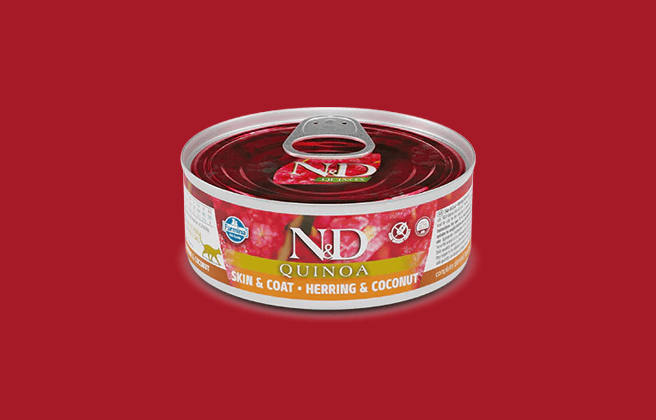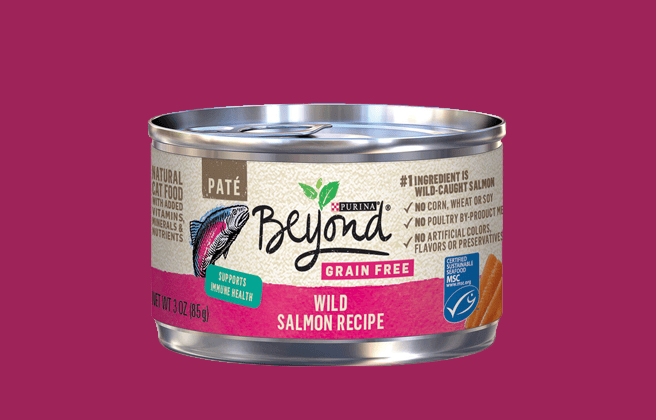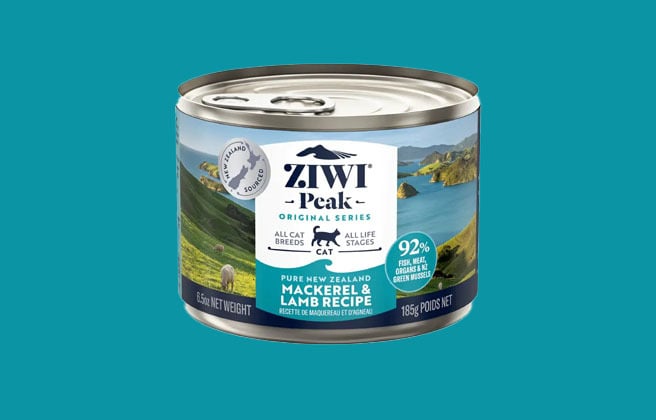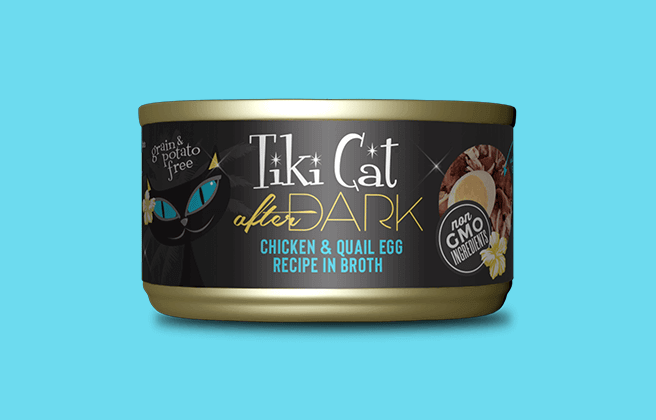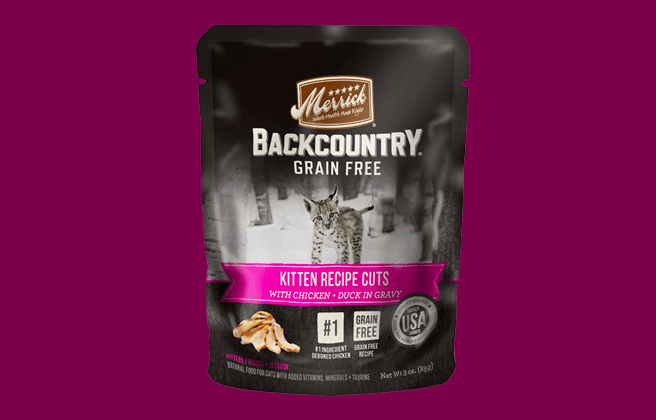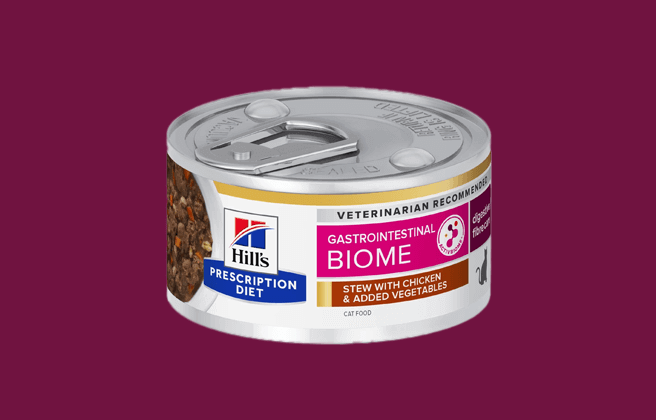
Our Verdict
Hill’s Prescription Diet wet cat food is made up of 31 recipes which are not rated due to their intentional therapeutic design.
Although this is a prescription product, our review has nothing to do with the accuracy of claims made by the manufacturer as to the product’s ability to treat or cure a specific health condition.
So, to find out whether or not this product is appropriate for your particular pet, it’s important to consult with your veterinarian.
Pros
- Science-led ingredients
- Wide range of products for different cats
- Quality protein ingredients
Cons
- Some recipes contain by-products
Each recipe includes its AAFCO nutrient profile: Growth (kitten), Maintenance (adult), All Life Stages, Supplemental or Unspecified.
Save up to 35%
with Autoship
See discount in cart
Ingredients Analysis
Hill’s Prescription Diet Gastrointestinal Biome Stress Chicken & Vegetable Stew Cat Food (formulated for digestive and fibre care).
This food has been chosen as a representative of the range, even though each recipe may be designed for different veterinary conditions.
The first ingredient is chicken broth. Broths are of only modest nutritional value. Yet because they add both flavor and moisture to a cat food, they are a common component in many wet products.
The second ingredient is chicken which is considered “the clean combination of flesh and skin… derived from the parts or whole carcasses of chicken”.1 Chicken is naturally rich in the 11 essential amino acids required by a cat to sustain life.
The third ingredient is pork liver, an organ meat sourced from a named animal and thus considered a beneficial component.
The fourth ingredient is carrots which are rich in beta-carotene, minerals and dietary fiber.
The fifth ingredient is rice starch, a starchy powder extracted from rice and most likely used here as a thickening agent.
The sixth ingredient is wheat gluten. Gluten is the rubbery residue remaining once wheat has had most of its starchy carbohydrate washed out of it. Compared to meat, glutens are inferior plant-based proteins low in some of the essential amino acids dogs need for life.
This inexpensive plant-based ingredient can significantly boost the total protein reported on the label — a factor that must be considered when judging the actual meat content of this cat food.
The seventh ingredient is spinach. Due to its exceptional vitamin and mineral content, spinach exhibits a remarkably high nutrient Completeness Score[1. Completeness Score is a measure of a food’s relative nutrient content and is computed by NutritionData.com from the USDA’s National Nutrient Database for Standard Reference] of 91. For cats who are predisposed to oxalate stones spinach should be avoided, due to it’s high oxalate content.
The eighth ingredient is ground pecan shells, a low-cost, low-quality source of insoluble fiber. Fiber can help support healthy digestion and improve stools.
From here the list goes on to include a number of other items. But to be realistic, ingredients located this far down the list (other than nutritional supplements) are not likely to affect the overall rating of the product.
However, there is one notable exception. . . this recipe includes dried beet pulp, a controversial ingredient, a high fiber by-product of sugar beet processing. Some denounce beet pulp as an inexpensive filler while others cite its outstanding intestinal health and blood sugar benefits.
We only call your attention here to the controversy and believe the inclusion of beet pulp in reasonable amounts in most cat foods is entirely acceptable.
Save up to 35%
with Autoship
See discount in cart
Final Word
Hill’s uses qualified experts to formulate its products in one of the world’s leading research facilities. There are blends that are great for cats of all ages, from kittens to seniors as well as recipes to suit cats with health conditions such as diabetes, obesity and a sensitive stomach.
Has Hill's Prescription Diet cat food been recalled in the past?
Yes, there have been several recalls. Details can be found on the Dog Food Advisor, but in summary:
In 2007, there was an industry-wide recall which impacted Hill’s Science, due to food being contaminated with melamine. The contamination resulted in severe sickness and death among cats and dogs.
In 2014, there was another recall of Hill’s Science Diet dog food, due to potential salmonella contamination.
A year later, Hill’s initiated a market withdrawal which affected several dog food varieties. The recall was a result of labeling issues.
In late 2019, Hill’s was also forced to recall canned dog food from their Prescription and Science Diet lines. This was a result of unusually high vitamin D content. High vitamin D levels cause blood calcium to rise, resulting in organ failure and possibly death.
However, this did not just affect Hill’s Science Diet. About two months later, other pet food brands were recalled over vitamin D-related issues.
You can view a complete list of all cat food recalls since 2021 here.
To stay on top of any cat food product recalls, sign up for our free email alerts, here.
About
Hill’s Pet Nutrition is an international pet food brand that’s known for selling scientifically developed foods.
The company was founded in 1907 by Burton Hill as a rendering service with a contract to dispose of dead and lame animals in Topeka, Kansas.
It has come a long way since, now employing a team of more than 220 veterinarians, nutritionists, technicians, and food scientists to develop pet foods in the Hill research facility still located in Topeka.
Best cat foods
We uphold the highest editorial standards when creating the authoritative content pet parents rely on and trust.
Every piece of clinical content on the Cat Food Advisor is reviewed by our certified Veterinary Advisory Board, which consists of licensed veterinarians and medically certified specialists.
Our reviews are completely independent; we are not paid by any pet food company to promote their products favorably. We do not accept money, gifts, samples or other incentives in exchange for special consideration. For more information see our Disclaimer & Disclosure page.




